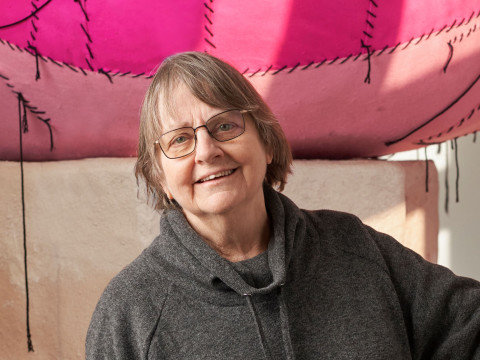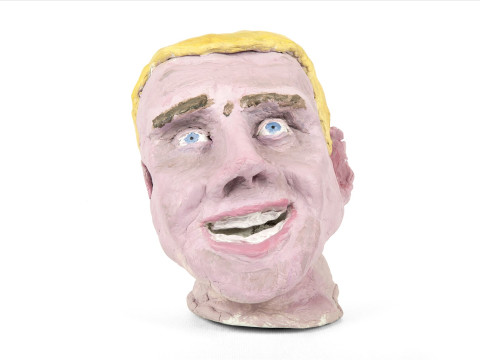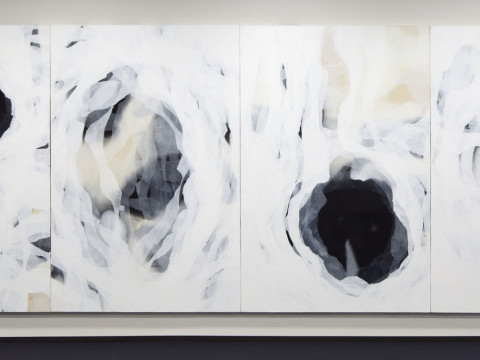
Body and Void at The Henry Moore Foundation
By Tara Contractor
Published on 12 May 2014
A new exhibition juxtaposing the works of Henry Moore with those of Antony Gormley RA, Richard Deacon RA and Anish Kapoor RA, among others, shows the enduring influence of one of Britain's most iconic sculptors.
With its clouds of pink apple blossom and lamb-filled lawns, the Henry Moore Foundation at Perry Green is like a world lost in time. A new exhibition, however, is bringing contemporary artists to the hamlet for the first time since Moore’s death. Featuring artists from Joseph Beuys to Damien Hirst, Body and Void explores how Moore’s interest in void, or opened volume, pervades contemporary sculpture.

The exhibition begins outdoors, where Moore’s sculptures mingle with newly installed works by artists like Royal Academicians Tony Cragg, Richard Deacon and Richard Long. Cragg declares that Moore’s work leaves the viewer “in no doubt that he is in the presence of great sculptural intelligence.” Paralleling Moore’s Reclining Figure: External Form, Cragg’s Early Forms St Gallen coils around an empty volume and tempts viewers to look inside it.

Deacon explains that Moore was not an early influence on his work, calling him “the elephant in the room for my generation, something so big you couldn’t see him.” In Associate, however, he responds to Moore’s Locking Piece by creating four interlocking skeletal frames. Viewers can look through this metallic structure to the sky and hills beyond, but the eye is equally drawn to the dark paint on sculpture’s interior.

Long, meanwhile, has created a stripe of untrimmed grass along a north-south magnetic line. As curator Anita Feldman explains, “Perry Green has its own little world, this world of Henry Moore…what Richard Long’s piece does is make us think about the earth, so it connects us externally.” Upstairs in the gallery, Moore’s photographs of standing stones, and of his own outdoor sculptures, are on display alongside Long’s photographs of A Circle in Alaska and A Line in Japan, sculptures created in remote areas using found materials. Though Long and Moore initially seem disparate, their juxtaposition highlights Moore’s connection to the landscape.

Moore’s experiments with interior and exterior space have psychological resonances that are explored in a small room inside the gallery. The deep voids in Helmet Head No.4 Interior Exterior and Working Model for Upright Internal/External Form make fascinating counterparts to Anish Kapoor’s hypnotic Untitled, a mirror-like surface that distorts the viewer’s reflection as it recedes into the wall. Equally mesmerising are Antony Gormley’s Sense and Still Feeling, hollow sculptures cast from the artist’s body. Gormley meditates as the plaster sets around him, and the finished works convey this sense of inner quietude.

The show’s final section highlights younger artists who question Moore’s legacy. Simon Starling’s film Project for a Masquerade (Hiroshima) critiques Moore’s advocacy of nuclear energy by inserting him into a Japanese folktale about deceit and betrayal. Meanwhile, Roger Hiorns spoofs the permanence of Moore’s earthbound sculptures with Two Forms Orange and Brown, a hanging sculpture that belches soap bubbles.

Ubiquitous worldwide, Moore’s work can sometimes feel outworn. Body and Void, however, proves that Moore remains an unavoidable presence for today’s artists. In the words of director Richard Calvocoressi, the exhibition "is not designed to say that this is how Moore influenced Anish Kapoor or Richard Deacon or Antony Gormley or Damien Hirst. It’s not as simple as that…. It’s a sort of dialogue really between Moore and those who came after him." Indeed, by bringing new voices to Perry Green, Body and Void gives viewers fresh perspective on Moore’s relevance.
Body and Void is at the The Henry Moore Foundation until 26 October 2014.
Tara Contractor is a contributor to RA Magazine.


